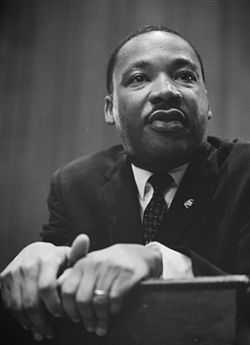Martin Luther King Jr. National Historic Site
|
Martin Luther King Jr. National Historic Site and Preservation District | |
|
U.S. National Historic Site | |
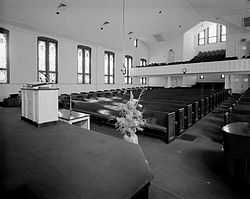 | |
|
Interior of Ebenezer Baptist Church, view from behind the pulpit. | |
 | |
| Location | Roughly bounded by Courtland, Randolph, Chamberlain Sts. and Irwin Ave. (original) and Roughly bounded by Freedom Pkwy., John Wesley Dobbs Ave., Decatur St., Southern RR tracks, and I-75/85 (increase), Atlanta, Georgia |
|---|---|
| Coordinates | 33°45′18″N 84°22′20″W / 33.75500°N 84.37222°WCoordinates: 33°45′18″N 84°22′20″W / 33.75500°N 84.37222°W |
| Area |
34.47 acres (13.95 ha) 13.04 acres (5.28 ha) federal) |
| Built | 1929 |
| Architect | Multiple |
| Architectural style | Late 19th And Early 20th Century American Movements, Modern Movement |
| Visitation | 624,848 (2005) |
| Governing body | Local and National Park Service |
| NRHP Reference # | 74000677, 80000435, 00000741[1] |
| Significant dates | |
| Added to NRHP |
May 2, 1974 (original) June 12, 2001 (increase) |
| Designated NHLD | May 5, 1977[2] |
| Designated NHS | October 10, 1980 |
Martin Luther King Jr. National Historic Site established on October 10, 1980, consists of several buildings surrounding Martin Luther King Jr.'s boyhood home on Auburn Avenue in the Sweet Auburn historic district of Atlanta, Georgia. The original Ebenezer Baptist Church, the church where King and his father Martin Luther King, Sr. pastored, is also part of the national historic site. These places are critical components in the interpretation of the life of Martin Luther King Jr. and his legacy as a leader of the American Civil Rights Movement.
In total, the buildings included in the site make up 35 acres (0.14 km²). The visitor center contains a museum that chronicles the American Civil Rights Movement which follows the parallel paths of Dr. Martin Luther King Jr.. A firehouse (Fire Station No. 6), built in 1894, served the Sweet Auburn community until 1991, and now contains a gift shop and an exhibit on desegregation in the Atlanta Fire Department. The “I Have a Dream” International World Peace Rose Garden, and a memorial tribute to Mohandas K. Gandhi. Also of interest is the "International Civil Rights Walk of Fame" which gives recognition to some of those courageous pioneers who worked and sacrificed to make equality a reality for all.
Annual events surrounding Martin Luther King Jr. Day in January typically draw large crowds. Speakers have included Presidents of the United States, national and local politicians, and civil rights leaders. Remembrances are also held during Black History Month (February), and the anniversary of King's April 4, 1968, assassination.
Preservation

As Martin Luther King Jr. Historic District, an area bounded roughly by Irwin, Randolph, Edgewood, Jackson, and Auburn Avenues was listed on the U.S. National Register of Historic Places on May 2, 1974.[1][3] The district included Ebenezer Baptist Church, the MLK grave site, the MLK birthplace, shotgun row houses, Victorian houses, the Alexander Hamilton House, the Atlanta Baptist Preparatory Institute site, Our Lady of Lourdes Catholic Colored Mission, Fire Station No. 6, and the "Triangle Building" at the intersection of Old Wheat St. and Auburn Avenue.[3]
Some or all of the area was designated a national historic landmark district on May 5, 1977.[2]
By U.S. Congressional legislation, the site became a national historic site on October 10, 1980 and is administered by the National Park Service (NPS).[4] A 22.4-acre (91,000 m2) area including 35 contributing properties was covered, including 22 previously included in the NRHP historic district.[4]
The area covered in the NRHP designation was increased on June 12, 2001.[1]
King Birth Home
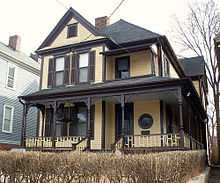
The King Birth Home is located at 501 Auburn Avenue. It was built in 1895, about one block east of Ebenezer Baptist Church in the National Historic Site.[5] Martin’s maternal grandparents, Reverend Adam Daniel (A.D.) Williams and Jennie Williams, bought the house for $3,500 in 1909. Williams was pastor of the nearby Ebenezer Baptist Church. When King's father married Alberta Williams, the family moved into the house in 1926. It is the place where Martin Luther King Jr. was born in 1929. The King family lived in the house until 1941,[6] and the house was then converted into a two-family dwelling. The Rev. A.D. Williams King, Dr. King's brother, lived on the second floor in the 1950s and early 1960s.
The first level includes the front porch, parlor, study, dining room, kitchen, laundry, bedroom and a bathroom. The second level includes four bedrooms and a bathroom. The visitor center offers free tours of the house led by National Park Service rangers, but with limited availability.[7]
King Center
Coretta Scott King started the Martin Luther King Jr. Center for Nonviolent Social Change in the basement of the couple's home in the year following King's 1968 assassination.[8] In 1981, the center was moved into a multimillion dollar facility on Auburn Avenue, near King's birth home and next to Ebenezer Baptist Church, where he preached from 1960 until his death.
In 1977, a memorial tomb was dedicated, and the remains of Martin Luther King Jr. were moved from South View Cemetery to the plaza that is nestled between the center and the church. Martin Luther King Jr.'s gravesite and a reflecting pool are also located next to Freedom Hall. Mrs. King was interred with her husband on February 7, 2006. An Eternal Flame is also located nearby.
Freedom Hall at 449 Auburn Avenue features exhibits about Dr. and Mrs. King, Mahatma Gandhi and Rosa Parks, and hosts special events and programs. It contains a Grand Foyer, large theater/conference auditorium, bookstore and resource center and various works of art from across the globe. The Grand Foyer features art from Africa and Georgia, and the paneling lining the staircase is from the sapeli tree which grows in Nigeria.
As of 2006, the King Center is a privately owned inholding within the authorized boundaries of the national historic site. However, there is debate within the King family on whether it should remain so or be sold to the National Park Service.
Visitor Center
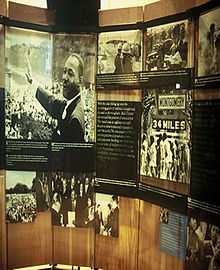
The visitor center at 449 Auburn Avenue[9] was built in 1996 and features the multimedia exhibit Courage To Lead, which follows the parallel paths of Dr. Martin Luther King Jr. and the Civil Rights Movement. Visitors can also walk down a stylized "Freedom Road". The Children of Courage exhibit, geared towards children, tells the story of the children of the Civil Rights Movement with a challenge to our youth today. Video programs are presented on a continuing basis and there is a staffed information desk.[10]
Gandhi Promenade
The statue of Mohandas Gandhi was donated by The Indian Council for Cultural Relations, India, in collaboration with The National Federation of Indian American Associations and The Embassy of India, USA. The inscribed bronze plaque reads:[11]
- "Nonviolence, to be a potent force, must begin with the mind. Nonviolence of the mere body without the cooperation of the mind is nonviolence of the weak of the cowardly, and has, therefore, no potency. It is a degrading performance. If we bear malice and hatred in our bosoms and pretend not to retaliate, it must recoil upon us and lead to our destruction."--Gandhi
- "Tribute to the Mahatma "Gandhi was inevitable. If humanity is to progress, Gandhi is inescapable. He lived, thought and acted, inspired by the vision of humanity evolving toward a world of peace and harmony. We may ignore him at our own risk"--Martin Luther King Jr.
International Civil Rights Walk of Fame
The "International Civil Rights Walk of Fame" was created in 2004 and honors some of the participants in the Civil Rights Movement. The walk along the Promenade, includes footsteps, marked in granite and bronze. According to the National Park Service, the Walk of Fame was created to "pay homage to the "brave warriors" of justice who sacrificed and struggled to make equality a reality for all." The new addition to the area is expected to enhance the historic value of the area, enrich cultural heritage, and augment tourist attractions.
The “Walk of Fame” is the brainchild of Xernona Clayton, founder and executive producer of the renowned Trumpet Awards and a civil rights activist in her own right. Ms. Clayton said, “This is a lasting memorial to those whose contributions were testaments to the fact that human progress is neither automatic nor inevitable. This historic site will serve as a symbol of pride and a beacon of hope for all future generations. We are looking forward to building a monument to the civil struggle that depicts every step taken toward the goal of justice and the tireless exertions and passionate concern of these dedicated individuals.”[12]
Photo gallery
-
The Martin Luther King Jr. National Historic Site honors the life of Dr. King
-
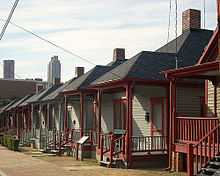
Shotgun houses on Auburn Ave. directly across from Dr. King's boyhood home
-

Shotgun houses in historic district
-

Late 19th/Early 20th century homes on Auburn Ave. in the Martin Luther King Jr. historic district
Notes
- ↑ 1.0 1.1 1.2 "National Register Information System". National Register of Historic Places. National Park Service. 2009-03-13.
- ↑ 2.0 2.1 "Martin Luther King Jr. Historic District". National Historic Landmark summary listing. National Park Service. Retrieved 2008-06-21.
- ↑ 3.0 3.1 Mendinghall, Joseph Scott (1974). "National Register of Historic Places Inventory-Nomination: Martin Luther King Jr. Historic District (Landmark)" (PDF). National Park Service. Retrieved 2009-06-28. and Accompanying 11 photos, from 1965 and 1972-1974 PDF (4.99 MB)
- ↑ 4.0 4.1 Robert W. Blythe, Maureen A. Carroll, and Steven H. Moffson (October 15, 1993). "National Register of Historic Places Registation: Martin Luther King Jr. National Historic Site" (PDF). National Park Service. Retrieved 2009-06-28. and Accompanying 75 photos PDF (16.9 MB)
- ↑ Virtual Tour of Birth Home
- ↑ The Martin Luther King Jr. National Historic Site and Places that Commemorate His Legacy
- ↑ "NPS: Fees and Reservations". National Park Service. July 22, 2008. Retrieved 2009-08-31.
- ↑ Future of King Center up in the air (February 1, 2006)
- ↑ http://www.thekingcenter.org/
- ↑ "Visitor Center", Dr. Martin Luther King Jr. National Historic Site, National Park Service site
- ↑ The Gandhi Promenade at the Martin Luther King National Historic Site
- ↑ Footsteps of Civil Rights Leaders
References
- Coleman, Wim. Martin Luther King Jr. National Historic Site, Enslow Pub. Inc, (2005) - ISBN 0-7660-5225-7
External links
| Wikimedia Commons has media related to Martin Luther King, Jr., National Historic Site. |
- Official NPS website: Martin Luther King Jr. National Historic Site
- International Civil Rights Walk Of Fame Announces 2008 Inductees
- International Civil Rights Walk of Fame
- Ebenezer Baptist Church official site
- The King Center
- Atlanta, Georgia, a National Park Service Discover Our Shared Heritage Travel Itinerary
- Facts and trivia


